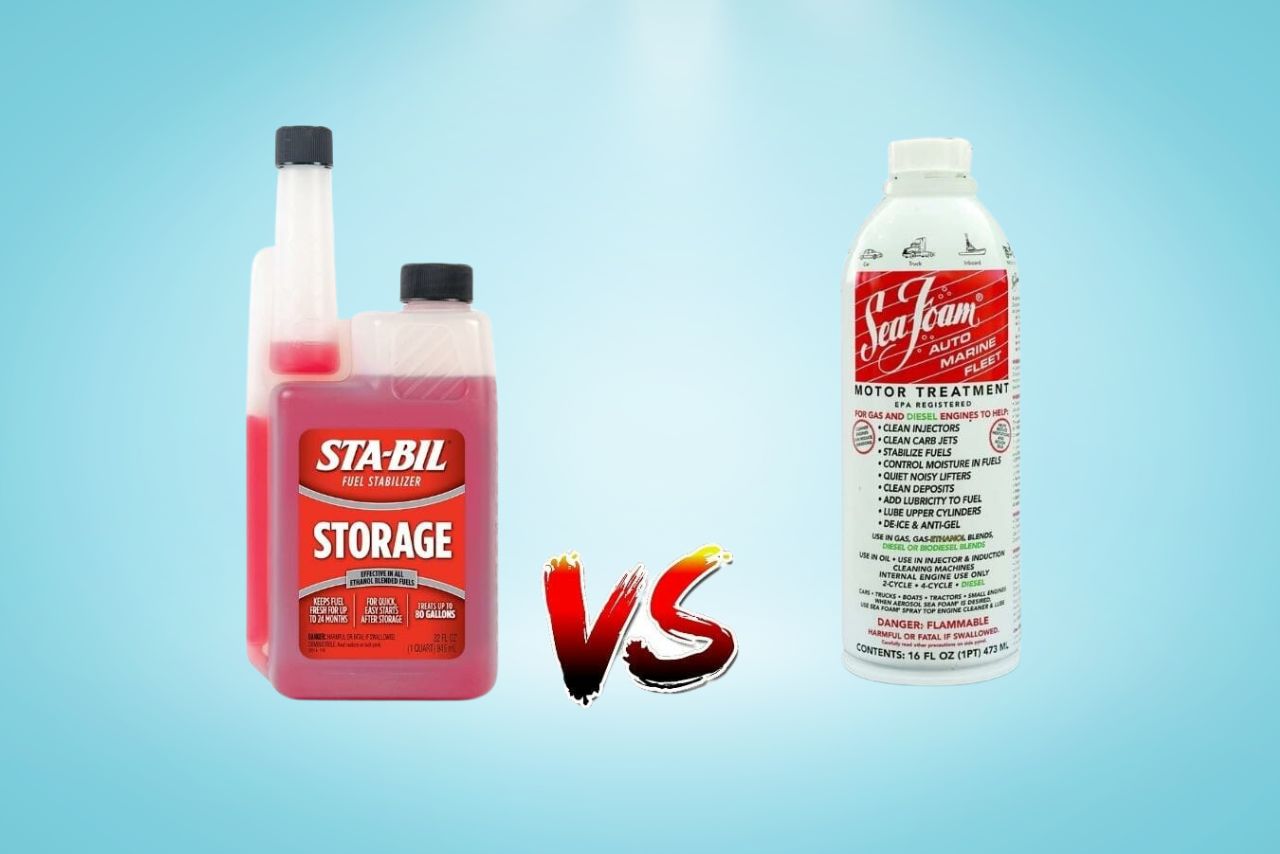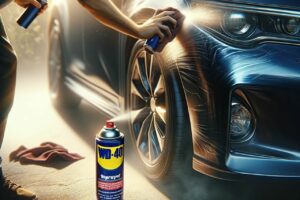If you’re a vehicle owner or an avid DIYer, chances are you’ve come across the terms “Seafoam” and “Stabil” when it comes to fuel stabilizers.
But which one should you choose? In this article, we’ll compare Seafoam and Stabil to determine which fuel stabilizer is better for your needs.
| Image | Title | Brand | Prime | Buy |
|---|---|---|---|---|
| STA-BIL Diesel Fuel Stabilizer And Performance Improver – Keeps Diesel Fuel Fresh For Up To 12 Months – Lubricates And Cleans The Fuel System – Treats 320 Gallons, 32 fl. oz. (22254) | STA-BIL | PrimeEligible | Buy Now | |
| Sea Foam SF-16 Motor Treatment – 16 oz. , white | Sea Foam | PrimeEligible | Buy Now |
Prices and images pulled from the Amazon Product Advertising API on:
Both Seafoam and Stabil are popular choices among car enthusiasts who want to keep their engines running smoothly. They both claim to prevent fuel deterioration and protect against corrosion, but they have some key differences.
Stay tuned as we dive into the features, benefits, and potential drawbacks of each product so that you can make an informed decision on which fuel stabilizer is the best fit for your specific situation.
So, Seafoam vs Stabil: Which Fuel Stabilizer is Better?
If you’re looking for a product that can clean fuel deposits and improve engine performance, then Seafoam is a good choice. If you’re just looking for a product to prevent fuel from going bad, then Stabil is a good option.
Table of contents
What is Fuel Stabilizer?
- Safe to use in all diesel engines including agricultural and marine
- Safe to use in all diesel fuel, including ultra low sulfur diesel and bio-diesel
- Keeps diesel fuel fresh, for quick easy starts
- All STA-BIL branded products are good for use up to 2 years after the bottle was opened. Be sure to mark the date you opened the bottle on the back of your package!
Fuel stabilizer is a chemical additive that helps to preserve the quality and performance of fuel over an extended period.
It is particularly useful for fuels that are stored for long periods, such as in boats, lawnmowers, or other seasonal equipment.
Here’s what you need to know about fuel stabilizers:
Remember: Not all fuel stabilizers are created equal! In our next section, we will compare two popular brands: Seafoam vs Stabil – Which one comes out on top? Stay tuned!
Disclaimer: Always follow manufacturer instructions when using any chemical additives in your vehicle.
The Role of Seafoam in Fuel Stabilization:
- Replaces OEM Numbers: Sea Foam: SF16
- 100% New Aftermarket Sea Foam Motor Treatment built to meet OEM specifications
- 100 percent pure petroleum
- EPA registered product
- Liquefies gum and varnish deposits or internal engine contaminants
- Special Shipping Information: This item cannot be returned and has additional shipping restrictions
- Special Shipping Information: This item cannot be returned and has additional shipping restrictions
Fuel stabilizers like Seafoam are designed to prevent fuel degradation and ensure optimal performance of engines, particularly during periods of storage. Seafoam offers several key benefits when it comes to fuel stabilization:

To get maximum benefit from using Seafoam as a fuel stabilizer, follow the recommended dosage instructions provided by the manufacturer based on your specific needs and application requirements.
The Role of Stabil in Fuel Stabilization:

Fuel stabilizers play a crucial role in maintaining the quality and performance of stored fuels. When it comes to fuel stabilization, one popular option is Stabil. Here’s why Stabil is considered an effective fuel stabilizer:
- Prevents Fuel Oxidation: Stabil works by inhibiting the oxidation process that occurs when fuel is exposed to air over time. This prevents the formation of harmful varnish and gum deposits that can clog fuel lines, carburetors, and injectors.
- Extends Fuel Shelf Life: By reducing oxidation, Stabil helps extend the shelf life of stored fuels. It keeps gasoline fresh for up to 12 months and diesel for up to 24 months when used as directed.
- Protects Against Ethanol Damage: Ethanol-blended fuels are commonly used today but they can pose challenges during storage due to their tendency to absorb moisture from the air, causing phase separation and potential engine damage. Stabil contains special additives that help counteract these effects, protecting your engine against ethanol-related issues.
- Maintains Fuel Stability: With its advanced formula, Stabil ensures fuel stability even during prolonged storage periods or seasonal equipment downtime. It helps prevent sludge formation and maintains fuel integrity so that it remains ready-to-use whenever you need it.
- Easy Application Process: Using Stabil is simple; just add the recommended amount directly into your fuel tank before filling it with fresh gasoline or diesel. The product will mix thoroughly with your existing fuel upon use.
6Cost-Effective Solution: Investing in a high-quality stabilizer like Staibil can save you money in the long run by preventing costly repairs caused by degraded or contaminated fuels.
To summarize, if you’re looking for a reliable solution to maintain the quality of your stored fuels while protecting your engine against potential issues caused by ethanol blends, Stabil is a top choice.
Its ability to prevent fuel oxidation, extend shelf life, and provide overall fuel stability makes it an excellent fuel stabilizer option.
Key Differences Between Seafoam and Stabil:
| Image | Title | Brand | Prime | Buy |
|---|---|---|---|---|
| STA-BIL Diesel Fuel Stabilizer And Performance Improver – Keeps Diesel Fuel Fresh For Up To 12 Months – Lubricates And Cleans The Fuel System – Treats 320 Gallons, 32 fl. oz. (22254) | STA-BIL | PrimeEligible | Buy Now | |
| Sea Foam SF-16 Motor Treatment – 16 oz. , white | Sea Foam | PrimeEligible | Buy Now |
Prices and images pulled from the Amazon Product Advertising API on:
| Feature | Seafoam | Stabil |
|---|---|---|
| Price | More expensive | Less expensive |
| Effectiveness at cleaning fuel deposits | More effective | Less effective |
| Effectiveness at preventing fuel from going bad | Less effective | More effective |
| Effectiveness at improving engine performance | More effective | Less effective |
| Other uses | Can be used to clean and lubricate engines | Not as versatile |
When it comes to choosing a fuel stabilizer, two popular options are Seafoam and Stabil.
While both products serve the same purpose of preventing fuel degradation, there are some key differences that can help you decide which one is better suited for your needs.
Here’s a breakdown of these differences:
Composition:
Fuel Compatibility:
Benefits:
- Seafoam:
- Cleans injectors/fuel systems by removing deposits.
- Provides lubrication for upper cylinders during storage periods.
- Helps remove moisture from the fuel system.
- Stabil:
- Prevents phase separation caused by ethanol-blended fuels.
- Protects against corrosion caused by moisture accumulation in the tank.
- Extends the shelf life of stored fuel for up to 24 months.
- Application: Both products require different application methods: Product Application Seafoam Add directly into the fuel tank or through vacuum lines Stabil Mix with fresh fuel before filling the tank
- Cost: The cost may vary depending on location and retailer; however, generally speaking, Stabil tends to be slightly more expensive than Seafoam.
Effectiveness Comparison: Seafoam vs Stabil:
When it comes to fuel stabilizers, both Seafoam and Stabil are popular choices among car enthusiasts.
But how effective are they at keeping your fuel fresh and preventing engine issues? Let’s compare the effectiveness of Seafoam and Stabil in this head-to-head comparison.
Both Seafoam and Stabil prove themselves as reliable contenders when it comes to preserving fuel quality over time and safeguarding engine performance.
While Seafoam may have a slight edge in terms of fuel stability, both products excel at ethanol protection, engine performance enhancement, and fuel system cleaning. Ultimately, the choice between Seafoam and Stabil comes down to personal preference and individual needs.
Considerations When Choosing a Fuel Stabilizer:
| Image | Title | Brand | Prime | Buy |
|---|---|---|---|---|
| STA-BIL Diesel Fuel Stabilizer And Performance Improver – Keeps Diesel Fuel Fresh For Up To 12 Months – Lubricates And Cleans The Fuel System – Treats 320 Gallons, 32 fl. oz. (22254) | STA-BIL | PrimeEligible | Buy Now | |
| Sea Foam SF-16 Motor Treatment – 16 oz. , white | Sea Foam | PrimeEligible | Buy Now |
Prices and images pulled from the Amazon Product Advertising API on:
When deciding between Seafoam and Stabil as fuel stabilizers, there are several important factors to consider. Here are some key considerations that can help you make an informed decision:
Environmental Impact:
Many consumers today prioritize eco-friendly options when making purchasing decisions—consider researching whether either product offers any environmental benefits or certifications like being biodegradable or low VOC (volatile organic compound).
User Reviews:
Finally don’t underestimate user reviews – they can provide valuable insights into real-world experiences with a particular fuel stabilizer.
Take the time to read reviews and consider feedback from others who have used Seafoam or Stabil.
Remember, selecting the right fuel stabilizer depends on your specific needs and preferences. By considering these factors, you can make an informed decision that will help preserve the quality of your stored fuel for longer periods.
Tips for Properly Using Seafoam or Stabil:
When it comes to using fuel stabilizers like Seafoam and Stabil, there are a few key tips to keep in mind. Follow these guidelines to ensure you get the best results and protect your engine:
Remember that while both Seafoam and Stabil can help stabilize fuels and improve engine performance, they are not miracle solutions. Regular maintenance and proper usage are essential for the longevity of your vehicle or equipment.
| Tips for Properly Using Seafoam or Stabil: |
|---|
| Read the instructions carefully |
| Choose the right product based on your needs |
| Add stabilizer before storage |
| Use recommended dosage according to tank size |
| Start with a clean fuel system |
| Mix thoroughly after adding stabilizer |
| Consider regular use for ongoing benefits |
Conclusion and final thoughts 💭
In the battle of Seafoam vs Stabil, it is clear that both fuel stabilizers have their advantages and limitations. However, when it comes to overall performance and effectiveness, one product stands out as the better option.
Seafoam has proven to be a more reliable fuel stabilizer due to its multiple functionalities.
Not only does it stabilize fuel for extended periods, but it also cleans the engine from harmful deposits and lubricates crucial components. This dual-action formula ensures optimal engine performance and longevity.
On the other hand, while Stabil does an adequate job at preventing fuel degradation over time, it lacks additional benefits like engine cleaning and lubrication. It primarily focuses on maintaining fuel quality without addressing potential issues caused by carbon buildup or varnish formation inside the engine.
Therefore, if you’re looking for a comprehensive solution that not only stabilizes your fuel but also improves your engine’s health, Seafoam is undoubtedly the superior choice in this comparison.
By using Seafoam regularly, you can ensure a smoother running engine with reduced maintenance requirements.
Make sure to consult your vehicle manufacturer’s recommendations before choosing any fuel stabilizer and always follow proper usage instructions provided by each product’s manufacturer.
Latest Posts:
- Can WD-40 Remove Scratches on Cars? (Hint: Yes, but…)
- Can You Use a Drill to Polish Your Car? (We Tried it Out!)
- Should You Cover Car Scratches With Stickers? (REVEALED!)
- Buick Service Stabilitrak: (Causes & 100% Guaranteed Fix!)
- Common Holden Trax Problems (Causes & 100% Proven Fixes!)
- Jeep Commander Transmission Over Temp: (Guaranteed Fix!)












Leave a Reply